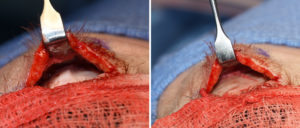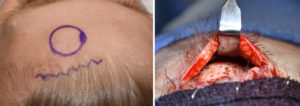Background: Osteomas are well known benign bony outgrowths that commonly occur on the skull. They are composed of mature solid bone that appears an a ballooning or circular outcropping from the skull’s surface. Their growth is slow and their progression in size is of one of years. They are reported to most commonly occur between the third and fifth decades of life but can occur at any age.
The reason osteomas develop is not precisely known. Osteomas that occur on the outer surface of the skull presumably occur by growth from the overlying periosteum. This leads to the theory that it develops as a reaction to trauma and even by minor amounts that may not be remembered by the patient. This seems a most logical explanation in forehead osteomas given the not infrequent bumping of one’s forehead that can occur. This may also explain their reported greater occurrence in men. Although interestingly I have treated far more forehead osteomas in women.
While osteomas are innocuous and pose no medical risks, their size and visible presence on the forehead is a motivating factor for their requested removal.
Case Study: This young female presented with a firm circular raised mass on her left upper forehead. It had been slowly growing over the past the years and had become increasingly noticeable. She had no recountable history of trauma to her forehead.


Highlights:
1) Forehead osteomas are common and can appear anywhere on the visible forehead.
2) A pretrichial hairline incision offers the least invasive approach to upper forehead osteomas if a good hairline present.
3) Burring reduction is the most effective treatment of forehead osteomas of incisional access permits.
Dr. Barry Eppley
Indianapolis, Indiana



